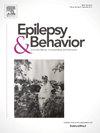Impact of seizure outcome and extent of neocortical resection on emotional well-being in patients with epilepsy one year after temporal lobe surgery
IF 2.3
3区 医学
Q2 BEHAVIORAL SCIENCES
引用次数: 0
Abstract
Background
Seizure frequency and cognitive function are common parameters in assessing epilepsy surgery outcomes. However, psychobehavioral outcomes, such as symptoms of depression and quality of life (QOL), have not found equal attention yet.
Objective
To assess the effect of seizure frequency, the extent of resection, and cognitive function on the psychobehavioral outcome of patients after temporal lobe surgery for pharmacoresistant epilepsy.
Methods
We retrospectively reviewed all consecutive patients who underwent surgery for intractable temporal lobe epilepsy between 09/2015 and 07/2019. We examined seizure outcome, surgical plan, resection volume, cognitive functions, and psychobehavioral outcome.
Results
This study included 77 patients (31 males, 46 females) who underwent temporal lobe surgery. One year after surgery, 53 patients (68.8 %) were completely seizure-free (Engel IA) and 92.2 % of patients showed a worthwhile improvement in seizure frequency (Engel I-III). Resection volume was significantly negatively correlated with QOL (r = − 0.284, p = 0.041). However, after controlling for the effect of seizure outcome, no significant correlation remained. Patients with a worthwhile improvement in seizure frequency showed significantly fewer symptoms of depression (p = 0.024) and a significantly higher QOL (p = 0.012) one year after surgery. The differences in symptoms of depression (p = 0.044) and QOL (p = 0.030) between patients with and without improvements in seizure frequency remained significant after controlling for the effect of resection volume. After procedures sparing the amygdala and hippocampus (neocortical resection), patients presented significantly fewer symptoms of depression (p = 0.044) and significantly better QOL (p = 0.008) than patients after procedures involving mesial-temporal structures, independent of the resection volume, and after controlling for the side of the procedure (dominant vs. non-dominant). After also controlling for seizure outcome, the difference remained for QOL (p = 0.014) but not for symptoms of depression.
Conclusions
A patient’s emotional well-being one year after surgery for pharmacoresistant temporal lobe epilepsy strongly depends on their seizure outcome. As an individual factor, the extent of neocortical resection negatively affects postsurgical emotional well-being, but a favorable seizure outcome outweighs this effect, independent of the resection volume. A favorable seizure outcome even outweighs the negative effects of procedures involving mesial-temporal structures on symptoms of depression.
癫痫发作结果和新皮质切除范围对颞叶手术一年后癫痫患者情绪的影响。
背景:癫痫发作频率和认知功能是评估癫痫手术效果的常见参数。然而,抑郁症状和生活质量(QOL)等心理行为结果尚未得到同等关注:评估癫痫发作频率、切除范围和认知功能对药物耐药性癫痫颞叶手术后患者心理行为结果的影响:我们回顾性研究了2015年9月至2019年7月期间因难治性颞叶癫痫接受手术治疗的所有连续患者。我们研究了癫痫发作结果、手术方案、切除量、认知功能和心理行为结果:本研究纳入了77名接受颞叶手术的患者(31名男性,46名女性)。术后一年,53 名患者(68.8%)完全无癫痫发作(Engel IA),92.2%的患者癫痫发作频率有明显改善(Engel I-III)。切除体积与 QOL 呈明显负相关(r = - 0.284,p = 0.041)。然而,在控制了癫痫发作结果的影响后,两者之间不再存在明显的相关性。癫痫发作频率明显改善的患者在术后一年抑郁症状明显减少(p = 0.024),生活质量明显提高(p = 0.012)。在控制了切除量的影响后,癫痫发作频率有所改善和没有改善的患者在抑郁症状(p = 0.044)和生活质量(p = 0.030)方面的差异仍然显著。在保留杏仁核和海马(新皮质切除)的手术后,患者的抑郁症状(p = 0.044)和 QOL(p = 0.008)明显少于涉及颞中叶结构的手术后患者,这与切除体积无关,并且在控制了手术侧(优势侧与非优势侧)后也是如此。在控制了癫痫发作结果后,QOL(p = 0.014)方面的差异依然存在,但抑郁症状方面的差异则不存在:结论:药物耐药性颞叶癫痫患者术后一年的情绪健康状况在很大程度上取决于其发作结果。作为一个个体因素,新皮质切除的范围会对术后的情绪稳定产生负面影响,但良好的癫痫发作结果会超过这种影响,这与切除量无关。良好的癫痫发作结果甚至超过了涉及颞中叶结构的手术对抑郁症状的负面影响。
本文章由计算机程序翻译,如有差异,请以英文原文为准。
求助全文
约1分钟内获得全文
求助全文
来源期刊

Epilepsy & Behavior
医学-行为科学
CiteScore
5.40
自引率
15.40%
发文量
385
审稿时长
43 days
期刊介绍:
Epilepsy & Behavior is the fastest-growing international journal uniquely devoted to the rapid dissemination of the most current information available on the behavioral aspects of seizures and epilepsy.
Epilepsy & Behavior presents original peer-reviewed articles based on laboratory and clinical research. Topics are drawn from a variety of fields, including clinical neurology, neurosurgery, neuropsychiatry, neuropsychology, neurophysiology, neuropharmacology, and neuroimaging.
From September 2012 Epilepsy & Behavior stopped accepting Case Reports for publication in the journal. From this date authors who submit to Epilepsy & Behavior will be offered a transfer or asked to resubmit their Case Reports to its new sister journal, Epilepsy & Behavior Case Reports.
 求助内容:
求助内容: 应助结果提醒方式:
应助结果提醒方式:


